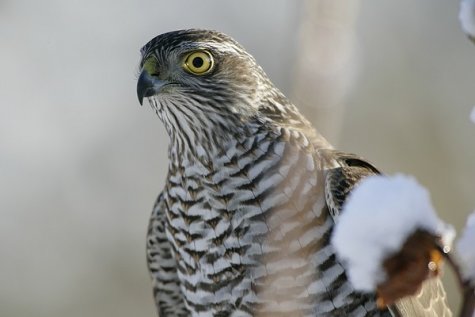The raptor comes
Photo: Arne Ader
Translation: Liis
Sparrowhawk
| Sparrowhawk |
Raudkull
|
Accipiter nisus |
During the winter the sparrowhawk and the goshawk are the only raptors of the falcon order in Estonia. We will introduce both these flying virtuosos – easily confused with each other, most easily the female sparrowhawk and the male goshawk. The reason for introducing them is simple, both have already been observed in quieter outskirts of towns. The quarry of these raptors in such places are passerines and domestic pigeons but even corvid family members are harassed. As usual among the Falconiformes raptors the female bird is quite a bit larger. Winter numbers are estimated at one thousand up to a couple of thousand individuals. The number of goshawks has decreased markedly during later years; they not only compete with sparrowhawks for food but, being bigger and stronger, are also direct enemies from whom it is necessary to hide when they appear.
The size of a sparrowhawk is comparable to a jackdaw. The male bird is easily recognised from its rust-coloured, lengthwise streaked underparts. The breast plumage of the female bird is streaked in grey and the colour of the underparts is similar to that of the goshawk, but it has a narrower tail. The juvenile birds are similar to the female bird. Sparrowhawks have yellow eyes; from Arne’s photo we can make a preliminary identification. Near gardens the sparrowhawk is the most often observed bird of prey, and it is not unusual that they hunt near winter bird feeders where their quarry gathers. A female sparrowhawk, about ¼ larger than the male, even manages to slay domestic pigeons. The prey is brought away, carried in the claws. In nature they keep to the edges of open landscapes; among small rodents bank voles seem to be most attractive.
Passerines are caught in flight and the success of the attack depends on the speed and unexpectedness, when the prey is plucked from among a flock of birds feeding on the ground. The small and slender hawk has extremely fast wingbeats and approaches its prey flying very near the ground, in a gliding flight mode. Their ability to avoid obstacles in a forest is amazing. The explanation is as expected: hawks have an extraordinarily well developed eyesight, the eyes are very large, placed at the sides of the head and very mobile. The focusing ability of the eye lens is many times faster than it is for humans, and thus also the reaction speed. Scientists believe that hawks can distinguish colours.
More about the goshawk soon.









